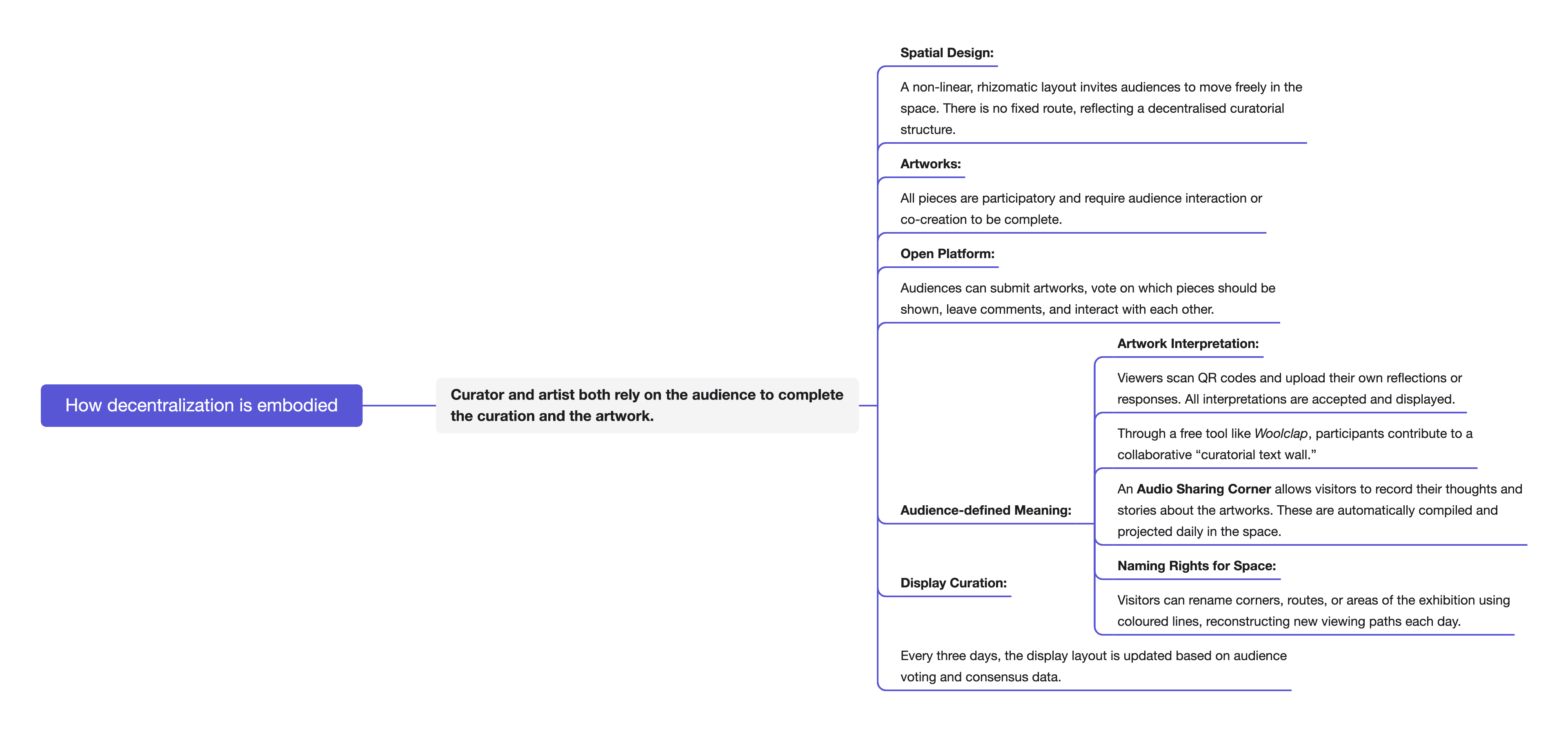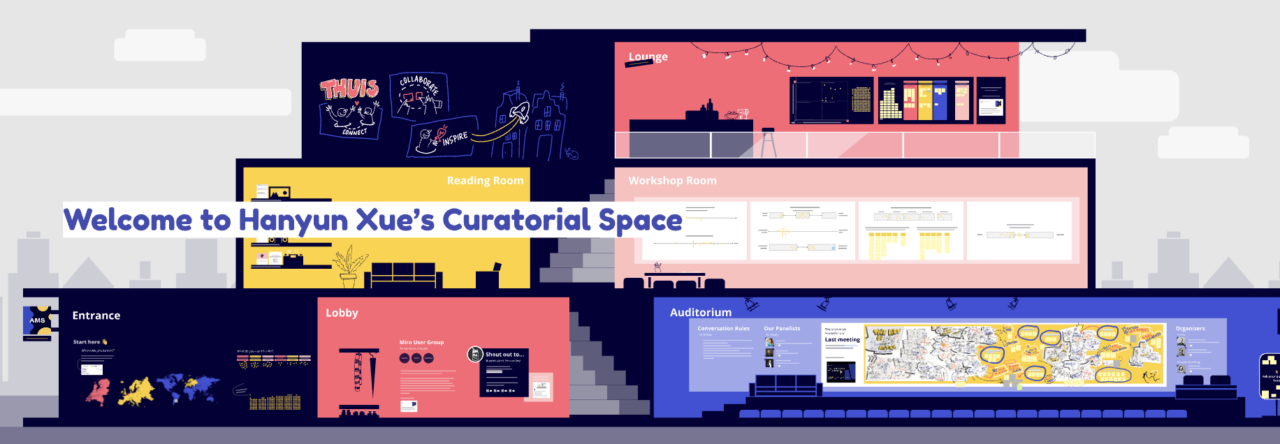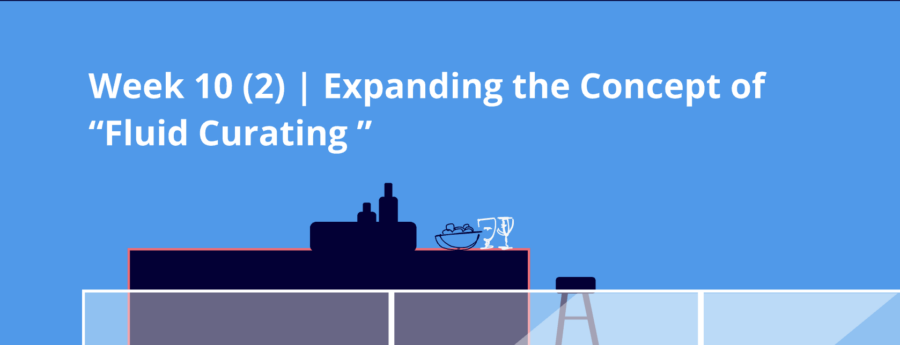🌊 My Exhibition Is Not a “Finished Product,” But a Flowing Relationship
This week, I finally gathered the courage to sort through the curatorial ideas that had been drifting in my head for a long time.
From questioning whether curators should hold total control, to writing down the full framework for my project “Fluid Curating,” I feel like I’ve found a direction that is both gentle and powerful.
This exhibition doesn’t present an outcome. Instead, it invites everyone to co-create the process itself.
📍Project Title: Fluid Curating
Subtitle: A Decentralised Ecosystem of Co-Creation
Keywords: Decentralisation, Co-Creation, Participatory Curation, Audience Agency, Interactive Installation, Non-linear Space, Dynamic Display, Collective Text-Making, Art + Data Feedback
📌 Venue: Edinburgh College of Art (ECA) Main Building Lobby
- Online Open Curatorial Platform (for voting and text interaction)
The online and offline components will be fully integrated. The exhibition is no longer limited to one location, but becomes a continually evolving space of shared creation.
🧭 Curatorial concept: How to embody “decentralization”?

1.🎨 Artists / Artworks
- Participatory works by ECA CAP students
- Community-sourced participatory artworks
All works require audience interaction to be completed. Here, the audience is not just a viewer, but a co-creator.
2.🗓 Duration
- On-site exhibition: 7 days (updated daily based on audience contributions)
- Online platform: Open for 14 days (for ongoing discussion, artwork submission, text gathering, feedback, and data collection)
We hope this mechanism of “daily change” encourages ongoing participation and allows the exhibition to breathe and grow.
3.🧭 Layout Without a Map
The exhibition will take place in the ECA main building lobby. We’ll abandon linear routes and create a rhizomatic layout—
Everyone navigates based on their own steps and emotions.
Coloured lines will be arranged on the floor. Audiences can name areas and pathways: some might call it the “Hallway of Tenderness,” while others rename it the “Unfinished Memory.”
Every name changes daily. Every line might mean something new tomorrow.
4.🎧 Sound as Resonance, Not Just Ambience
I imagined a corner called the “Sound Bazaar.”
You can put on headphones and hear stories left by others,
or press a button and record your feelings about a piece.
You can stay anonymous, or speak your name. It’s not a statement. It’s a connection.
These recordings will rotate daily, like a slowly growing radio programme,
curated by all of us, together.
5.🖋 Curatorial Text, Written by Everyone
There are no fixed labels or curator-written statements. Instead, each artwork will be paired with a QR code. Audience members can scan and use Woolclap, a free platform, to write their interpretation.
These words will be projected onto the wall in real-time, forming a flowing audience-generated language wall.
Some write stories, others memories, some just leave a single word.
All of it becomes the curatorial text—not the explanation, but the emotion.
6.🌀 The Audience as Installer and Meaning-Maker
- Every three days, we’ll rearrange displays based on audience votes
- Visitors can vote, comment, name sections, and actively participate in the works
- The whole exhibition is a living system that evolves with interaction
I want to show that an exhibition is not a fixed space, but a network of ongoing relationships.
7.🧭 Curatorial Ethics
- All audience contributions (voice/text) can be submitted anonymously or with credit
- All content will go through moderation to avoid bias or harm
- Data is used only for analysis and remains open-access, not for commercial use
While we decentralise curatorial power, we also build gentle and trustworthy boundaries.
🎤 Public Lecture: Who Gets to Define Curatorial Discourse?
We’ll host an open conversation titled “The Shift of Curatorial Power”, inviting lecturers, students, and visitors to join.
Our aim is to show:
Curatorial discourse can be redistributed. Audiences, participants, and creators all have the right to be producers of meaning.
♿Accessibility
- Audio guides and bilingual (Chinese/English) interface
- Quiet hours and low-sensory zones
- Navigation and access co-designed with ECA students with disabilities
- Multi-sensory experiences (sound and touch as alternatives to visuals)
We want everyone to enter the exhibition in their own way.
💹 Post-Exhibition Outputs
- A collaboratively written Zine featuring audience-created curatorial texts, sold as a takeaway souvenir
- A “Decentralised Art Market Trend Report” summarising voting results, feedback, and interaction data—offered as insight for artists and local institutions
Every vote, every comment, every interaction will be recorded, respected, and allowed to shine beyond the exhibition.
🗺 Timeline
| Week | Activity |
|---|---|
| W1–W2 | Concept development, artist open call, communication with CAP students and venue coordination |
| W3–W4 | Platform building, tool testing, material preparation |
| W5 | Installation and soft launch testing audience flow |
| W6 | Full exhibition launch: daily interactions + data collection + co-creation processes |
| W7 | Final wrap-up, Zine editing, and trend report compilation |
💰 Budget
| Item | Amount |
|---|---|
| Multimedia equipment | £400 |
| Exhibition materials (fabric, lighting, etc.) | £300 |
| Promotional materials | £150 |
| Zine printing | £300 |
| Artist transport + volunteer support | £200 |
| Contingency fund | £200 |
📌 Tutorial Feedback & Next Steps
During this week’s tutorial, I received clear and constructive feedback from my tutor:
- The venue has officially changed from FACT Liverpool to the ECA Main Building Lobby, which suits the participatory nature of my project better.
- I need to list the names of participating artists, especially those from the CAP course.
- Given the production demands and artist involvement, it was suggested that I slightly increase the budget to allow for artist fees and support.
- My public programme should be expanded, with more detailed planning around outcomes and visitor experience.
- I was also reminded to further develop the section on EDI (Equality, Diversity and Inclusion) and Ethics, especially considering audience co-creation and content moderation.
- And finally, I must ensure that everything clearly aligns with the Learning Outcomes of the course.
These reminders helped me see the gaps in my current plan. I’m now revisiting the structure of my public events, adding clearer frameworks for things like the sound radio rotation, collaborative zine editing, and how the audience’s voice will be projected and documented across the space.
In the next blog, I’ll begin filling in those details—step by step~

